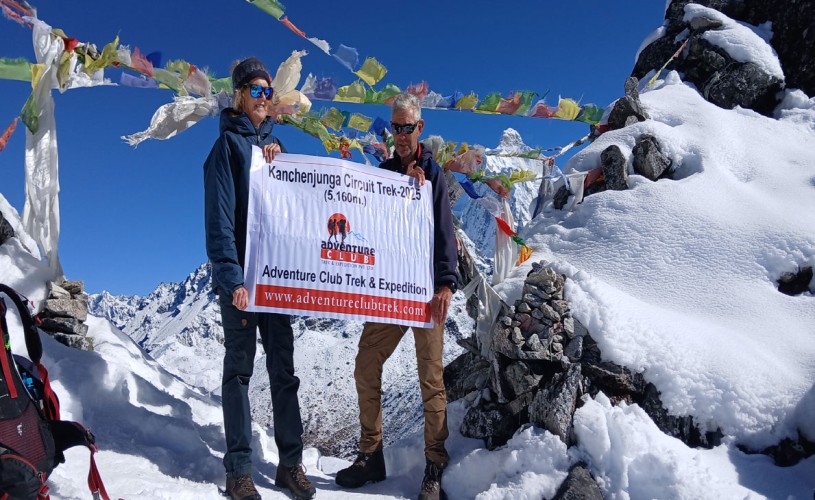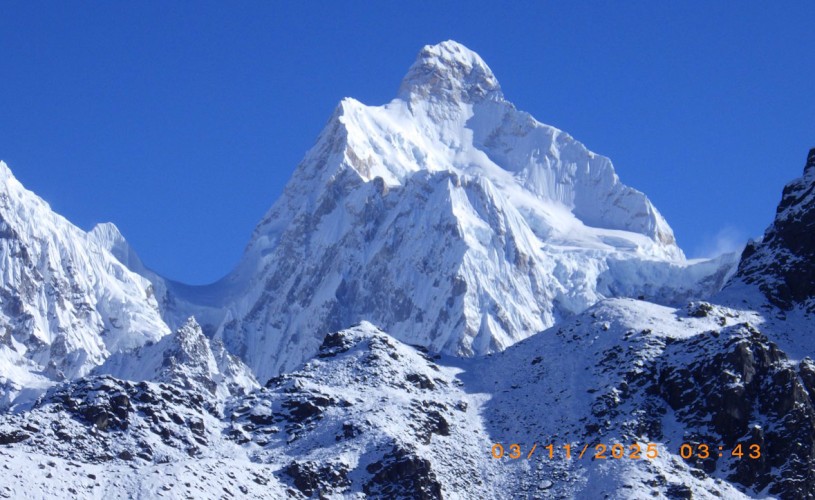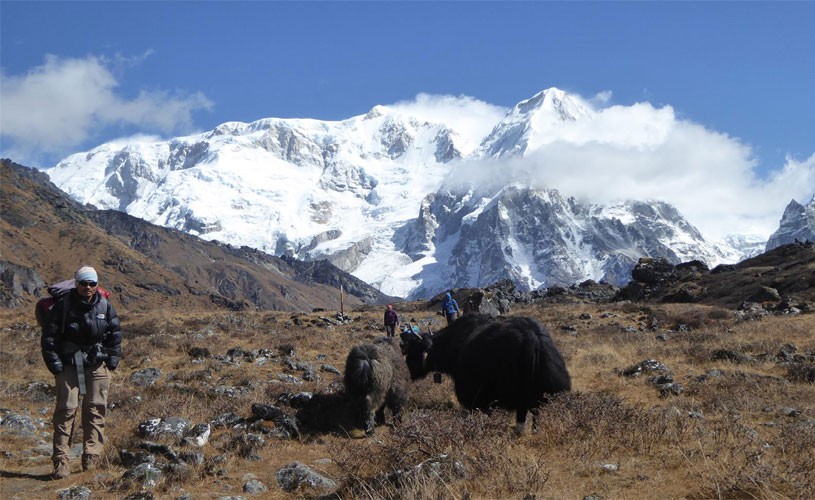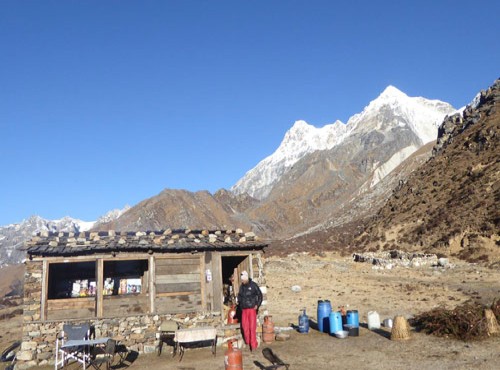Kanchenjunga Circuit Trek Highlights:
- Challenging & remote trek near India & Tibet borders
- Breathtaking views of Mt. Kanchenjunga (3rd highest peak)
- Passes Jannu Kabru & Rathong peaks
- Diverse landscapes: forests, pastures, barren terrains
- Abundant wildlife: red panda, snow leopard, musk deer, birds
- Explore local ethnic groups (Rais, Limbus, Sherpas)
- Visit charming villages, experience local culture & cuisine
- Solitude & tranquility away from crowds
- Highlight: Pangpema Base Camp (5,140m)
- High passes: Sele La Pass (4290m) & Sinion La Pass (4666m)
Kanchenjunga Circuit Trek 23-Day Itinerary & Cost For 2026
The Kanchenjunga Circuit Trek is one of Nepal’s most spectacular and off-the-beaten-path adventures. This remote trek leads you through the untouched highlands of eastern Nepal to the base of Mount Kanchenjunga (8,586 m)—the third-highest mountain in the world. Unlike the busy Everest and Annapurna trails, the Kanchenjunga route offers true solitude, rich mountain culture, and raw Himalayan landscapes few trekkers ever see.
The Kanchenjunga Trek is ideal for experienced trekkers seeking a more secluded and challenging Himalayan journey in eastern Nepal. As one of the less crowded high-altitude treks, it offers an unforgettable path through rhododendron forests, terraced farmlands, alpine valleys, and stone-built settlements shaped by Limbu, Rai, Magar, and Tibetan cultures. Located within a restricted trekking area, the region has remained largely untouched.
In 2025, Adventure Club Trek is making Kanchenjunga easier to access with custom itineraries, eco-lodges, and experienced local guides. Even as access improves, the region still feels wild and untouched—just as it has for generations. Trekkers must obtain both a Restricted Area Permit (RAP) and a Kanchenjunga Conservation Area Permit (KCAP)—essential for conserving the area's rare wildlife, rich biodiversity, and fragile ecosystems.
The Kanchenjunga Circuit Trek itinerary usually spans 22–24 days, starting with a 55-minute flight to Bhadrapur and an 8–9-hour drive to Taplejung. From here, the clockwise route typically moves through Chirwa, Lelep, Amjilosa, Mitlung, Sekathum, Gyabla, and Ghunsa, reaching both Kanchenjunga North and South Base Camps. Trekkers cross high passes like Sele La and visit stunning viewpoints, glaciers, and remote settlements along the way. Acclimatization days in Ghunsa and Tseram are essential due to the high altitude.
Surrounding the peaks are five major glacial systems—Zumu, Talung, and Rathong flow eastward into Sikkim, while the Kanchenjunga and Yalung glaciers descend into Nepal’s Tamor River basin. The Kanchenjunga Trek is a demanding adventure, ideal for those who are physically fit and have prior trekking experience.
The Kanchenjunga route offers mesmerizing views of towering mountains like Kanchenjunga, Jannu, and Kabru standing high above the hills. Along the way, you’ll pass small hillside monasteries, spinning prayer wheels, and slow-moving glaciers. If you’re lucky, you might even see rare animals like red pandas or snow leopards. A big part of the journey is connecting with locals—from Sherpa families and Tibetan monks to the Kirati people who’ve lived here for centuries. who have lived in this region for generations.
The ideal time to trek the Kanchenjunga Circuit is during spring (March–May) and autumn (September–November). These months offer clear skies, stable weather, and stunning mountain views. Winter is bitterly cold and hazardous at higher elevations, while the monsoon brings landslides and trail blockages.
The Kanchenjunga trek cost in 2025 depends on the package and services provided. On average, expect to pay $2,179–$2,989 for a full-board package including a guide, permits, meals, transportation, and accommodation. Budget options may vary, but it’s essential not to compromise safety in such isolated areas.
Start planning your 2025 Kanchenjunga Circuit Trek and experience one of the Himalayas’ last truly wild regions. This unforgettable journey brings a lifetime of memories and spiritual connection like no other trek in Nepal.
If the 22-day Kanchenjunga trek itinerary doesn't meet your needs or if you prefer a shorter itinerary of 18 days or 20 days, we are happy to customize the itinerary to suit your needs or requirements. Please let us know or contact us, and we will create a tailor-made itinerary for you.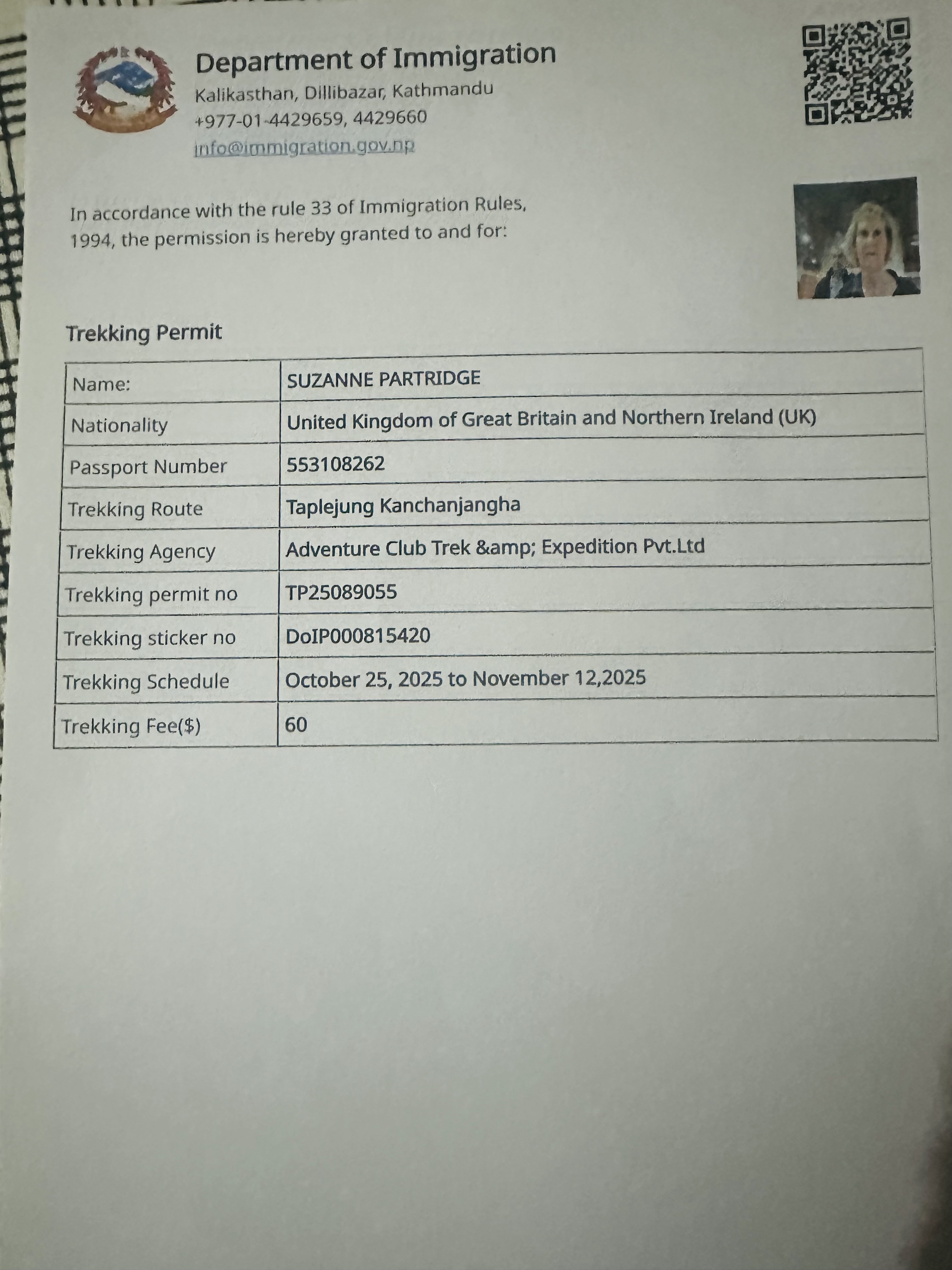
How difficult is the Kanchenjunga Circuit trek?
The Kanchenjunga Circuit Trek is a challenging but achievable journey for physically fit and mentally prepared people. Before the trek, trekkers should engage in regular cardio and strength training exercises to build muscle endurance for the steep ascents, descents, and river crossings. Hikers should practice hiking on uneven terrain while carrying a backpack to become comfortable with the challenge. Having the proper gear and equipment, such as sturdy hiking boots, warm clothing, a good-quality sleeping bag, and trekking poles, is vital. It is highly recommended to have a guide or porter familiar with the trail who can provide support and assistance throughout the journey. With adequate preparation, hikers can complete the Kanchenjunga Base Camp Trek in Nepal and appreciate the area's natural beauty and cultural richness.
How much does the Kanchenjunga circuit trek cost?
The Kanchenjunga Circuit Trek typically costs between $2,169 and $2,989 per person for a 22- to 24-day guided adventure. This price includes essential permits such as the Restricted Area Permit (RAP) and the Kanchenjunga Conservation Area Permit (KCAP), which together cost around $70 to $100. Hiring a licensed guide and porter usually adds $35–$45 per day, while transportation—flights to Bhadrapur and a jeep to Taplejung—can cost $300–$400 round trip. Daily expenses for food and basic teahouse accommodation range from $25 to $35. Most trekking agencies offer all-inclusive packages covering permits, logistics, meals, guides, porters, and lodging. While it's more remote and logistically complex than popular routes like Everest or Annapurna, the trek’s raw beauty and cultural richness make it well worth the cost. Additional expenses may include travel insurance, gear, and tips for the crew. Joining a group can reduce overall costs significantly.
When is the best time for the Kanchenjunga Circuit trek?
The best time to do the Kanchenjunga Circuit Trek is during autumn (September to November) and spring (March to May). These seasons offer clearer and more stable weather with fewer chances of rainfall or snowfall. The surrounding mountain ranges provide spectacular views, ideal for photography and sightseeing. The moderate temperature during these periods makes it comfortable for trekkers to hike. However, trekkers should be aware of the colder temperatures at higher altitudes, especially during winter (December to February). Planning your Kanchenjunga Circuit Trek during these months will guarantee a fantastic experience.
Accommodation on the Kanchenjunga Circuit Trek
Accommodation along the Kanchenjunga Circuit is basic but generally comfortable. Teahouses and lodges provide simple rooms equipped with beds, blankets, and pillows. Most places also have shared dining areas where trekkers can relax and enjoy local meals. Due to the trek’s remoteness, lodging and food options may be limited in certain areas. Bathrooms are usually shared, and hot showers are rare at higher elevations. Carrying a sleeping bag and a portable stove for emergencies is highly recommended.
Meals on the Kanchenjunga Circuit Trek
Meals on the trail include traditional Nepali dishes like dal bhat (lentils with rice) and momos (dumplings), along with occasional Western-style options such as pasta and pizza at select teahouses. Food is designed to be high in energy, with plenty of carbohydrates and nutritious ingredients to support endurance. Vegetarian meals are widely available. Since supplies are limited and costs can vary in remote areas, it’s smart to pack extra snacks and energy bars. Trekkers should also carry water or purification tablets, as access to clean drinking water is limited.
Drinking Water on the Kanchenjunga Circuit Trek
Staying hydrated is essential, especially at high altitudes where the risk of dehydration and altitude sickness increases. Because clean water sources are limited, trekkers should bring purification tablets or a water filter. Bottled water is available at some lodges, but it can be expensive. It's best to refill bottles at designated safe spots when possible. Avoid alcohol, as it contributes to dehydration and may hinder acclimatization.
What should I pack for the Kanchenjunga Circuit Trek?
Packing smartly is essential for the Kanchenjunga Circuit Trek, where conditions range from warm lowlands to freezing high passes. Must-have items include trekking boots, warm layers, a down jacket, a sleeping bag, gloves, and thermal wear. Rain gear and a lightweight backpack are also necessary. Don’t forget a headlamp, water purifier, trekking poles, sunscreen, lip balm, personal medicines, and quick-dry clothing. Since teahouses are basic, a power bank and toiletries are useful. Many agencies provide a duffel bag and a sleeping bag on loan. Keep your load light but complete—proper preparation ensures comfort, safety, and endurance throughout this long, high-altitude journey.
Is there internet and electricity during the Kanchenjunga Circuit Trek?
Internet and electricity access are extremely limited along the Kanchenjunga Circuit Trek, particularly in the higher mountain regions. Mobile network coverage disappears soon after Taplejung, and Wi-Fi is available only in a few lower-altitude lodges, such as those in Lelep, usually for a small fee. Even then, connections are slow, unstable, and often unreliable. Trekkers should prepare to disconnect for much of the journey and inform family or friends beforehand about the limited communication options. For safety and emergencies, carrying or arranging access to a satellite phone is the most dependable way to stay in touch in remote areas.
Electricity in the Kanchenjunga region is mainly supplied through solar panels and small generators, but power is intermittent and not available everywhere. Lodges typically charge a modest fee for recharging devices, with outlets usually located in shared dining areas rather than individual rooms. To stay prepared, trekkers are advised to carry a power bank, spare batteries, or a solar charger to keep essential devices powered. Embracing this digital disconnection allows you to fully experience the serene wilderness, remote villages, and pristine landscapes that make the Kanchenjunga Circuit one of Nepal’s most authentic and peaceful trekking routes.

